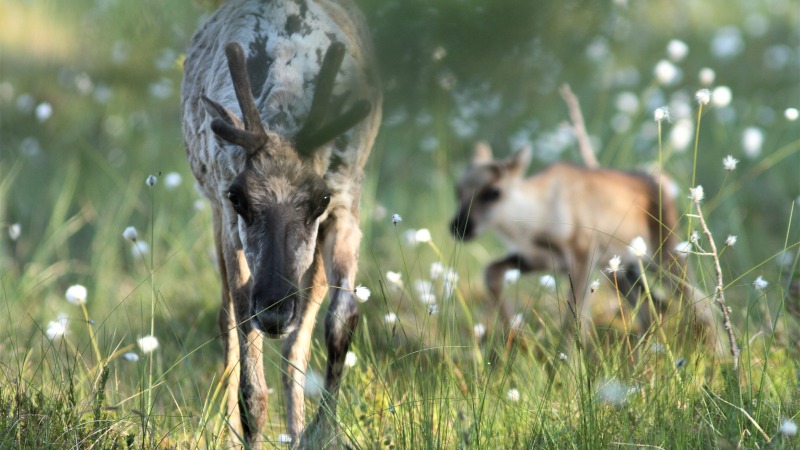WildForestReindeerLIFE

The wild forest reindeer once thrived throughout Finland but faced extinction by the early 20th century due to overhunting. However, a natural re-establishment in the 1950s and a successful reintroduction effort in the 1980s have led to a gradual increase in population, with approximately 3,000 individuals now residing in Finland. Despite conservation, challenges such as slow reproduction rates and habitat threats persist, necessitating ongoing conservation measures.
WildForestReindeerLIFE was launched in the autumn of 2016, with the collaboration of ten project partners. The project was coordinated by Metsähallitus Parks and Wildlife Finland. The project lasted over seven years, concluding at the end of 2023. As part of the project, wild forest reindeer (Rangifer tarandus fennicus) were reintroduced into two sites southwest of their current main occurrence range. Additionally, the project safeguarded the genome of existing wild subpopulations and the zoo population as well. Using individuals captured from the Kainuu subpopulation, a reinforcement translocation was conducted into the Suomenselkä subpopulation. Across the species’ range, the species was intensively monitored with GPS collars, and the population was comprehensively surveyed at the beginning and end of the project. Below, these activities are described in more detail.
The total project costs amounted to 4.97 million euros. Sixty percent of the funding was provided by the European Union. National co-funding was provided by the Ministry of Agriculture and Forestry (25.5%), the Ministry of the Environment (1%), and the project partners themselves (13.5%). Additionally, the Finnish Hunters’ Association supported the project.
Improving the knowledge base for successful conservation
The WildForestReindeerLIFE project significantly advanced our understanding of the subspecies’ dynamics through comprehensive studies on subpopulation sizes, movement patterns, and mortality factors. Utilizing GPS collars on female reindeer allowed for detailed monitoring, with 160 monitoring periods of 3-4 years collected during the project. GPS data guided conservation actions, facilitated aerial surveys, and aided in managing crossbreeding risks. Habitat modelling using GPS data highlighted critical calf nursing habitats, emphasizing the need for habitat protection and informed land use decisions. Aerial censuses provided population assessments, with counts revealing subpopulation sizes of 750 individuals in Kainuu and 1450–1500 individuals in Suomenselkä at the beginning of the project. Population trends were confirmed by subsequent censuses in 2022 and 2023, revealing that the Kainuu subpopulation ranged between 830 and 890 individuals, while the Suomenselkä subpopulation ranged between 1960 and 2000 individuals. These findings contribute to ongoing conservation efforts and inform management strategies for wild forest reindeer population in Finland.
Reclaiming the historic range by reintroductions
The WildForestReindeerLIFE project aimed to reintroduce the wild forest reindeer to new areas within its historical range, fostering the expansion of its distribution area. Reintroduction site selection involved meticulous planning, considering habitat availability, proximity to reindeer herding areas, and predator density. Social impact assessments were conducted to examine the local stakeholder support. Breeding enclosures were established in Lauhanvuori and Seitseminen National Parks in the latter half of 2017, initiating a five-year captive breeding period with founder individuals sourced both from zoos and the wild. Calving commenced in captivity in May 2018. In autumn 2019, the first individuals were released, followed by additional releases until July 2022, totaling 82 individuals across both national parks. Free-ranging calves for the released have been from May 2020 onwards, with an estimated total of 30 born in the wild. Both reintroduced populations exhibit natural reproduction, with survival rates deemed relatively favourable. Ongoing monitoring and support are essential to mitigate threats such as predation and ensure genetic diversity and long-term viability of the reintroduced subpopulations.
Reinforcement of an existing subpopulation
During the planning phase of the WildForestReindeerLIFE project, it was assumed that a small, genetically isolated wild forest reindeer subpopulation in the Ähtäri–Soini–Karstula area was disconnected from the Suomenselkä subpopulation. Originating from a reintroduction in the late 1980s and early 1990s, the Ähtäri–Soini–Karstula subpopulation consisted of zoo-born individuals with a known low genetic diversity. One project objective was to reinforce the Ähtäri–Soini–Karstula subpopulation by releasing additional individuals on three occasions to enhance its size and diversity. However, an initial attempt in autumn 2018, involving the introduction of adult zoo-born males into the enclosure, yielded unexpectedly tame behaviour from all released individuals. It had also become apparent that, contrary to the initial assumption, there was a connection between this subpopulation and Suomenselkä. Based on these findings, subsequent supplementation efforts were revised. In March 2021, four adult wild-caught females from the Kainuu subpopulation were transferred into the enclosure, where three gave birth in captivity before the entire herd was released in mid-summer. GPS tracking of the collared females confirmed their integration into the local wild forest reindeer population.
Protecting the wild forest reindeer genome
Protecting the genetic integrity of the wild forest reindeer population and preventing crossbreeding with semi-domestic reindeer are critical conservation goals. The potential for hybridization between these subspecies poses a significant threat to the wild forest reindeer genome. In regions where wild forest reindeer and semi-domestic reindeer coexist, preventive measures are essential. In Kainuu, a 90-kilometer conservation fence, erected in the 1990s, acts as a crucial barrier, supplemented during the WildForestReindeerLIFE project by repairing existing structures and constructing new pedestrian gates to enhance human crossings. Beyond the statutory reindeer herding area, semi-domestic reindeer kept as pets or for small-scale meat production pose a risk of crossbreeding if they escape from farms. A survey conducted during the project identified 59 small-scale reindeer farms or establishments outside the reindeer herding area, prompting advisory on preventing escapes and systematic reindeer marking. Although many escape incidents were not reported, evidence suggests occasional escapes, with some animals remaining missing. Implementation of new EU regulations in 2021 addressed deficiencies in reindeer farm registration and animal marking, enhancing conservation efforts.
Safeguarding the zoo population for future reintroductions
Zoos play a crucial role in conservation translocation and reintroduction initiatives, including the WildForestReindeerLIFE project, providing essential veterinary support and logistical assistance in capturing, transporting, and marking animals. Moreover, zoos supplied the majority of founder animals for breeding enclosures, establishing a strong foundation for wild forest reindeer reintroduction efforts. Sustaining the genetic diversity of zoo populations is imperative for future reintroduction endeavours. Before the project commenced, all wild forest reindeer individuals in European zoos traced back to just eight founders from the Kainuu subpopulation, emphasizing the need to enhance genetic diversity. During the project, six adult male wild forest reindeer were captured for breeding bulls in the reintroduction. After contributing their genes to new subpopulations in breeding enclosures, they were transferred to partner zoos, where they successfully acclimated. By the project’s end in 2023, five of these males had produced more than 30 offspring, increasing the number of founders in the ex situ population to 13.
From recovery to resilience: future steps for wild forest reindeer conservation
The WildForestReindeerLIFE project has achieved remarkable success, particularly with the reintroduction of wild forest reindeer into Lauhanvuori and Seitseminen National Parks. However, this success marks just the beginning of ongoing conservation efforts. Small populations, inherently vulnerable to environmental fluctuations, require continued support to establish and thrive. Future actions will focus on expanding reintroduced subpopulations and enhancing genetic diversity through additional releases. Long-term conservation strategies aim to promote connectivity between subpopulations, facilitating natural movement and interaction. Drained peatland restoration initiatives between subpopulations will aid in establishing permanent connections. Managing the risk of crossbreeding with semi-domestic reindeer remains a critical challenge, particularly as the Suomenselkä subpopulation expands towards reindeer herding areas. Proposed measures include constructing a further conservation fence between wild and semi-domestic reindeer areas and intensifying monitoring efforts. Given the difficulty in identifying hybrid individuals based on phenotype alone, the development of rapid DNA analysis tools is crucial for detecting hybridization. However, maintaining intensive conservation efforts requires substantial resources beyond national funding capacities. Plans for a new LIFE funding proposal to the EU aim to secure long-term resilience and viability for the wild forest reindeer population.
Last updated 19 July 2024
